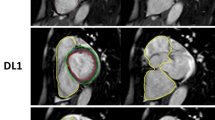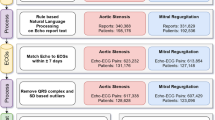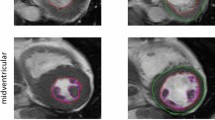Abstract
Purpose
Studies relating to the right ventricle (RV) are inadequate, and specific diagnostic algorithms still need to be improved. This essay is designed to make exploration and verification on an algorithm of deep learning based on imaging and clinical data to detect RV abnormalities.
Methods
The Automated Cardiac Diagnosis Challenge dataset includes 20 subjects with RV abnormalities (an RV cavity volume which is higher than 110 mL/m2 or RV ejection fraction which is lower than 40%) and 20 normal subjects who suffered from both cardiac MRI. The subjects were separated into training and validation sets in a ratio of 7:3 and were modeled by utilizing a nerve net of deep-learning and six machine-learning algorithms. Eight MRI specialists from multiple centers independently determined whether each subject in the validation group had RV abnormalities. Model performance was evaluated based on the AUC, accuracy, recall, sensitivity and specificity. Furthermore, a preliminary assessment of patient disease risk was performed based on clinical information using a nomogram.
Results
The deep-learning neural network outperformed the other six machine-learning algorithms, with an AUC value of 1 (95% confidence interval: 1–1) on both training group and validation group. This algorithm surpassed most human experts (87.5%). In addition, the nomogram model could evaluate a population with a disease risk of 0.2–0.8.
Conclusions
A deep-learning algorithm could effectively identify patients with RV abnormalities. This AI algorithm developed specifically for right ventricular abnormalities will improve the detection of right ventricular abnormalities at all levels of care units and facilitate the timely diagnosis and treatment of related diseases. In addition, this study is the first to validate the algorithm’s ability to classify RV abnormalities by comparing it with human experts.
Graphical abstract




Similar content being viewed by others
Availability of Data and Materials
The published datasets ACDC involved in the study are available from the original authors upon request. The artificial intelligence model code used in the study should be obtained by contacting the authors (panxiangbin@fuwaihospital.org).
Abbreviations
- ACDC:
-
Automated cardiac diagnosis challenge
- ANN:
-
Artificial neural network
- AUC:
-
Area under the receiver operating characteristic curve
- DCA:
-
Survival decision curve
- EF:
-
Ejection fraction
- LASSO:
-
Least absolute shrinkage and selection operator
- MRI:
-
Magnetic resonance imaging
- NMR:
-
Nuclear magnetic resonance
- RV:
-
Right ventricle
- SGD:
-
Stochastic gradient descent
- XGBoost:
-
EXtreme gradient boost
References
Harvey W (1975) Classic pages in obstetrics and gynecology. Exercitatio anatomica de motu cordis et sanguinis in animalibus. Am J Obstet Gynecol 121(7):1007. https://doi.org/10.1097/00000441-192904000-00020
Haddad F, Hunt S, Rosenthal DN, Murphy DJ (2008) Right ventricular function in cardiovascular disease, part I: Anatomy, physiology, aging, and functional assessment of the right ventricle. Circulation 117(11):1436–1448. https://doi.org/10.1161/CIRCULATIONAHA.107.653576
Haddad F, Doyle R, Murphy DJ, Hunt SA (2008) Right ventricular function in cardiovascular disease, part II: pathophysiology, clinical importance, and management of right ventricular failure. Circulation 117(13):1717–1731. https://doi.org/10.1161/CIRCULATIONAHA.107.653584
Sayed A, Pal S, Poplawska M et al (2020) Arrhythmogenic right ventricular cardiomyopathy diagnosis. Cardiol Rev 28(6):319–324. https://doi.org/10.1097/CRD.0000000000000292
Gemayel C, Pelliccia A, Thompson PD (2001) Arrhythmogenic right ventricular cardiomyopathy. J Am Coll Cardiol 38(7):1773–1781. https://doi.org/10.1016/s0735-1097(01)01654-0
Castaños-Gutiérrez SL, Kamel IR, Zimmerman SL (2016) Current concepts on diagnosis and prognosis of arrhythmogenic right ventricular cardiomyopathy/dysplasia. J Thorac Imaging 31(6):324–335. https://doi.org/10.1097/RTI.0000000000000171
Busse A, Rajagopal R, Yücel S et al (2020) Cardiac MRI-update 2020. Radiologe 60(Suppl 1):33–40. https://doi.org/10.1007/s00117-020-00687-1
Russo V, Lovato L, Ligabue G (2020) Cardiac MRI: technical basis. Radiol Med 125(11):1040–1055. https://doi.org/10.1007/s11547-020-01282-z
Bernard O, Lalande A, Zotti C et al (2018) Deep learning techniques for automatic MRI cardiac multi-structures segmentation and diagnosis: is the problem solved? IEEE Trans Med Imaging 37(11):2514–2525. https://doi.org/10.1109/TMI.2018.2837502
Nishie A, Kakihara D, Nojo T et al (2015) Current radiologist workload and the shortages in Japan: how many full-time radiologists are required? Jpn J Radiol 33(5):266–272. https://doi.org/10.1007/s11604-015-0413-6
Pinker S (2000) Private MRI clinics flourishing in Quebec. CMAJ 163(10):1326
Ouyang D, He B, Ghorbani A et al (2020) Video-based AI for beat-to-beat assessment of cardiac function. Nature 580(7802):252–256. https://doi.org/10.1038/s41586-020-2145-8
Chattopadhyay S, Dey A, Singh PK, Oliva D, Cuevas E, Sarkar R (2022) MTRRE-Net: a deep learning model for detection of breast cancer from histopathological images. Comput Biol Med 150:106155. https://doi.org/10.1016/j.compbiomed.2022.106155
Basu A, Sheikh KH, Cuevas E, Sarkar R (2022) COVID-19 detection from CT scans using a two-stage framework. Expert Syst Appl 193:116377. https://doi.org/10.1016/j.eswa.2021.116377
Van Griethuysen JJM, Fedorov A, Parmar C et al (2017) Computational radiomics system to decode the radiographic phenotype. Cancer Res 77(21):e104–e107. https://doi.org/10.1158/0008-5472.CAN-17-0339
Tibshirani R (1997) The lasso method for variable selection in the Cox model. Stat Med 16(4):385–395. https://doi.org/10.1002/(sici)1097-0258(19970228)16:4%3c385::aid-sim380%3e3.0.co;2-3
Schober P, Boer C, Schwarte LA (2018) Correlation coefficients: appropriate use and interpretation. Anesth Analg 126(5):1763–1768. https://doi.org/10.1213/ANE.0000000000002864
Kriegeskorte N, Golan T (2019) Neural network models and deep learning. Curr Biol 29(7):R231–R236. https://doi.org/10.1016/j.cub.2019.02.034
Li XL (2018) Preconditioned stochastic gradient descent. IEEE Trans Neural Netw Learn Syst 29(5):1454–1466. https://doi.org/10.1109/TNNLS.2017.2672978
Peterson LE (2009) K-nearest neighbor. Scholarpedia 4(2):1883. https://doi.org/10.4249/scholarpedia.1883
Stoltzfus JC (2011) Logistic regression: a brief primer. Acad Emerg Med 18(10):1099–1104. https://doi.org/10.1111/j.1553-2712.2011.01185.x
Black JE, Kueper JK, Williamson TS (2022) An introduction to machine learning for classification and prediction. Fam Pract 40(1):200–204. https://doi.org/10.1093/fampra/cmac104
Inoue T, Ichikawa D, Ueno T et al (2020) XGBoost, a machine learning method, predicts neurological recovery in patients with cervical spinal cord injury. Neurotrauma Rep 1(1):8–16. https://doi.org/10.1089/neur.2020.0009
Biau G, Scornet E (2016) A random forest guided tour. TEST 25(2):197–227. https://doi.org/10.1007/s11749-016-0481-7
Hwang EJ, Park S, Jin KN et al (2019) Development and validation of a deep learning-based automated detection algorithm for major thoracic diseases on chest radiographs. JAMA Netw Open 2(3):e191095. https://doi.org/10.1001/jamanetworkopen.2019.1095
Al-Antari MA, Hua CH, Bang J, Lee S (2021) Fast deep learning computer-aided diagnosis of COVID-19 based on digital chest x-ray images. Appl Intell (Dordr) 51(5):2890–2907. https://doi.org/10.1007/s10489-020-02076-6
Liu Z, Li W, Li H et al (2023) Automated deep neural network-based identification, localization, and tracking of cardiac structures for ultrasound-guided interventional surgery. J Thorac Dis 15(4):2129–2140. https://doi.org/10.21037/jtd-23-470
Castelvecchi D (2016) Can we open the black box of AI? Nature 538(7623):20–23. https://doi.org/10.1038/538020a
Kim S, Kim T-S, Lee WH (2022) Accelerating 3D convolutional neural network with channel bottleneck module for EEG-based emotion recognition. Sensors 22:6813. https://doi.org/10.3390/s22186813
Samee NA, Atteia G, Meshoul S, Al-antari MA, Kadah YM (2022) Deep learning cascaded feature selection framework for breast cancer classification: hybrid CNN with univariate-based approach. Mathematics 10:3631. https://doi.org/10.3390/math10193631
Al-Antari MA, Al-Masni MA, Kim TS (2020) Deep learning computer-aided diagnosis for breast lesion in digital mammogram. Adv Exp Med Biol 1213:59–72. https://doi.org/10.1007/978-3-030-33128-3_4
Acknowledgements
This study benefits from the high-quality data of previous studies whose true generosity has advanced cardiovascular medicine.
Funding
This evaluation study was supported by the following aspects: the Fundamental Research Funds for the Central Universities (2019PT350005); National Natural Science Foundation of China (81970444); Beijing Municipal Science and Technology Project (Z201100005420030); National high level talents special support plan (2020-RSW02); CAMS Innovation Fund for Medical Sciences (2021-I2M-1–065); Sanming Project of Medicine in Shenzhen (SZSM202011013).
Author information
Authors and Affiliations
Contributions
Conceptualization, methodology, software, validation, visualization, writing—original draft, ZL; resources, validation, visualization, WL; resources, validation, visualization, HL; resources, validation, visualization, FZ; resources, validation, visualization, WO; resources, validation, visualization, SW; resources, validation, visualization, AZ; conceptualization, methodology, writing—original draft, project administration, resources, writing—review editing, conceptualization, validation, XP.
Corresponding author
Ethics declarations
Conflict of Interest
All the authors disclosed no relevant relationships.
Ethical Approval and Consent to Participate
Not applicable.
Role of the Funder/Sponsor
The funders had no role in the design and conduct of the study; collection, management, analysis, and interpretation of the data; preparation, review, or approval of the manuscript; and decision to submit the manuscript for publication.
Rights and permissions
Springer Nature or its licensor (e.g. a society or other partner) holds exclusive rights to this article under a publishing agreement with the author(s) or other rightsholder(s); author self-archiving of the accepted manuscript version of this article is solely governed by the terms of such publishing agreement and applicable law.
About this article
Cite this article
Liu, Z., Li, H., Li, W. et al. Development of an Expert-Level Right Ventricular Abnormality Detection Algorithm Based on Deep Learning. Interdiscip Sci Comput Life Sci 15, 653–662 (2023). https://doi.org/10.1007/s12539-023-00581-z
Received:
Revised:
Accepted:
Published:
Issue Date:
DOI: https://doi.org/10.1007/s12539-023-00581-z




